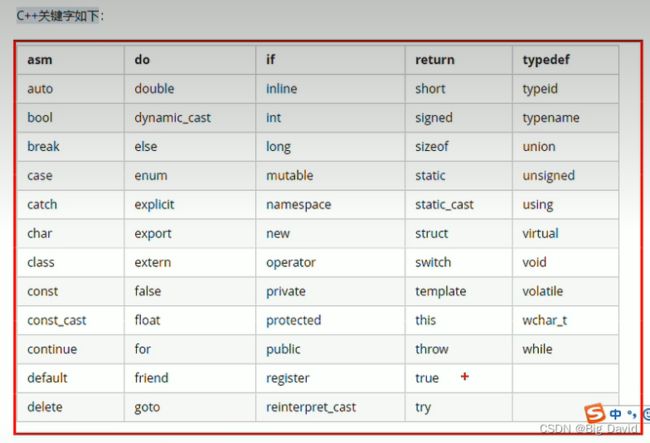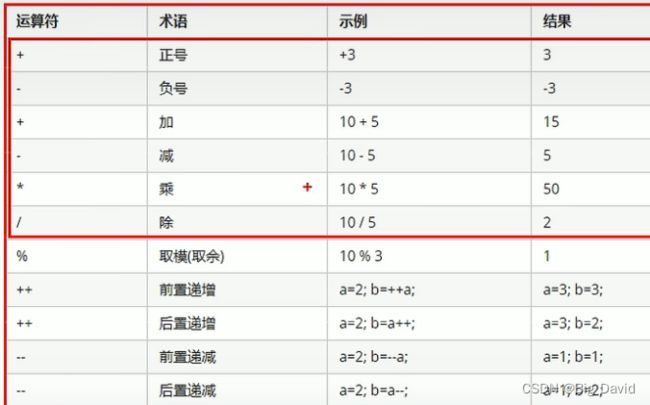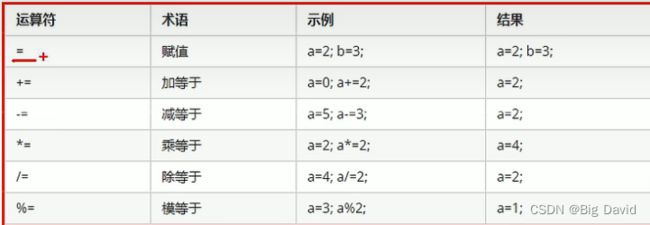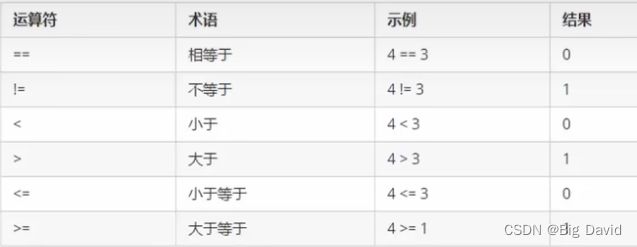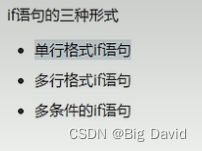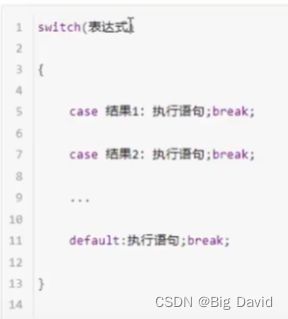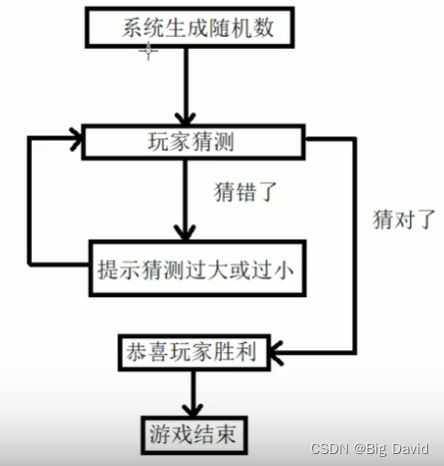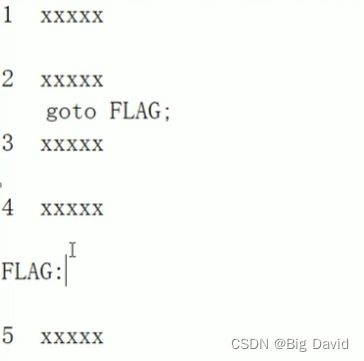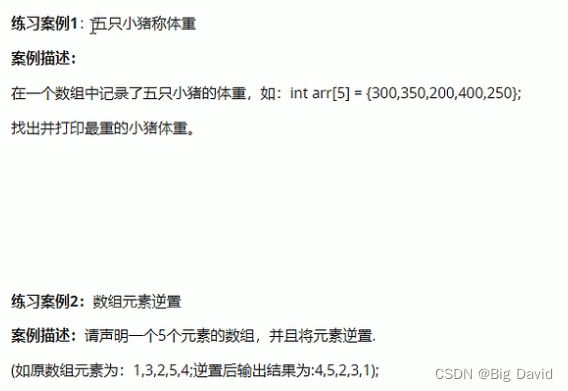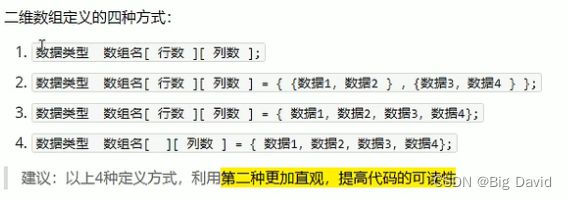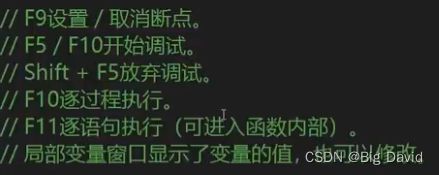C++基础从0到1入门编程(一)
系统学习C++
方便自己日后复习,错误的地方希望积极指正
参考视频:黑马程序员匠心之作|C++教程从0到1入门编程,学习编程不再难
1 第一个C程序-HelloWorld
编写一个C++程序分为四个步骤:
(1)创建项目
(2)创建文件
(3)编写代码
(4)运行程序
#include 2 程序的注释
编译器不会执行注释的内容
作用:代码添加说明,方便阅读
两种格式:
(1)单行注释://
通常放在语句的上方,或者一条语句的结尾
(2)多行注释:/**/
通常放在一段代码的上方
3 变量
变量存在的意义:方便我们管理内存空间
作用:给一段指定的内存空间起名,方便操作这段内存
语法:数据类型 变量名 = 初始值;
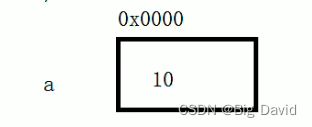
#include 4 常量
作用:用于记录程序中不可更改的数据
定义常量的方式:
(1)#define 宏常量:#define 常量名 常量值
通常在文件上方定义,表示一个常量
(2)const 修饰变量:const 数据类型 常量名 = 常量值
通常在变量定义前加关键字const,修改变量为常量,不可修改
#include 5 C++常用编程关键字
作用:C++预先保留的单词(标识符)
在定义变量或者常量时,不要用关键字,否则产生歧义
#include 6 标识符命名规则
作用:C++规定给标识符(变量、常量)命名时,有一套自己的规则
- 标识符不能是关键字
- 标识符只能由字母、数字、下划线组成
- 第一个字符必须为字母或者下划线
- 标识符中字母区分大小写
给变量起名的时候,最好能够做到见名知意。
7 数据类型
7.1 整型
C++规定在创建一个变量或者常量时,必须指定相应的数据类型,否则无法给变量分配内存。
数据类型存在意义:给变量分配合适的内存空间

#include 7.1.1 整数的书写
整数默认是十进制,一个表示十进制的数字不需要任何特殊的格式
(1)二进制
二进制由 0 和 1 两个数字组成,书写必须以0b或0B开头
(2)八进制
(3)十六进制
Tip:在C++中,不要在十进制数前面加0,会被编译器当成八进制,还有,不要随便删掉别人程序中整数前面的0,它不是多余的
#include 7.2 sizeof关键字
作用:利用sizeof关键字可以统计数据类型所占内存大小
语法:sizeof(数据类型 或者 变量)
#include 7.3 实型(浮点型)
作用:用于表示小数
(1)单精度 float
(2)双精度 double
区别:表示的有效数字范围不同

#include 7.4 字符型
作用:字符型变量用于显示单个字符
语法:char ch = 'a';
Tip:
(1) 在显示字符型变量,用单引号,不能用双引号
(2) 单引号内只能有一个字符,不能是字符串
C/C++字符型变量只占1个字节
字符型变量并不是把字符本身放到内存中存储,而是将对应的ASCIl编码放入到存储单元
#include 7.5 转义字符
作用:用于表示一些不能显示出来的ASCII字符
现阶段常用的转义字符:\n \\ \t
#include 7.6 字符串型
作用:用于表示一串字符
两种风格:
- C风格字符串:
char 变量名[] = "字符串值"; - C++风格字符串:
string 变量名 = "字符串值";
C++风格字符串,需要包含头文件
#include 7.7 布尔类型 bool
作用:布尔类型代表真或假的值
bool类型只有两个值:
- true (本质是1)
- false (本质是0)
bool类型占1个字节大小
#include 7.8 数据的输入
作用:用于从键盘获取数据
关键字:cin
语法:cin >> 变量
#include 7.9 typedef
创建数据类型的别名:
(1)为名称复杂的类型创建别名,方便书写和记忆
(2)创建与平台无关的数据类型,提高程序兼容性
typedef 原数据类型名 别名;
C++11还可以用using关键字创建数据类型的别名
using 别名=原数据类型名;
#include 8 运算符
8.1 算术运算符
8.2 赋值运算符
#include 8.3 比较运算符
#include 8.4 逻辑运算符
#include 9 程序流程结构
9.1 选择结构
9.1.1 if 语句
#include 案例:三只小猪称体重
有三只小猪ABC,请分别输入三只小猪的体重,并且判断哪只小猪最重
#include 9.1.2 三目运算符
语法:表达式1 ?表达式2 :表达式3
#include 9.1.3 switch语句
#include if 和 switch 区别
switch缺点:判断只能是整型或者字符型,不可以是一个区间
switch优点:结构清晰,执行效率高
9.2 循环结构
9.2.1 while
#include #include 9.2.2 do…while
#include do…while和while循环区别在于do…while会先执行一次循环语句
案例:水仙花数

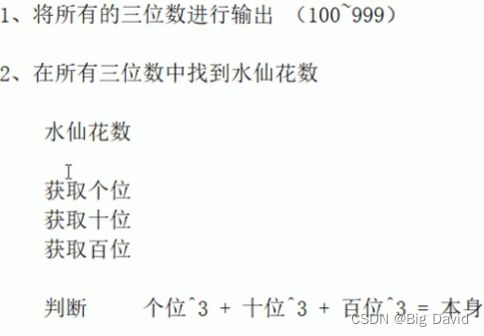
#include 9.2.3 for循环语句
#include #include 9.2.4 嵌套循环
#include 案例:乘法口诀表
#include 9.3 break语句
作用:用于跳出选择结构或者循环结构
使用:
- switch条件语句中,终止case并跳出switch
- 出现在循环语句中,作用是跳出当前的循环语句
- 出现在嵌套循环中,跳出最近的内层循环语句
#include 9.4 continue语句
作用:在循环语句中,跳过本次循环中余下尚未执行的语句,继续执行下一次循环
#include 9.5 goto语句
#include 10 数组
10.1 一维数组定义方式
特点:
(1)数组中每个数据元素都是相同的数据类型
(2)数组是由连续的内存位置组成的
#include Tip:
(1) 数组名的命名规范与变量名命名规范一致,不要和变量重名
(2) 数组中下标是从0开始索引
10.2 一维数组 - 数组名
一维数组名称的用途:
1、可以统计整个数组在内存中的长度 sizeof(arr)
2、可以获取数组在内存中的首地址 cout << arr << endl;
#include 五只小猪称体重
#include 数组元素逆置
#include #include 10.3 二维数组定义方式
#include 10.4 二维数组名
(1)查看二维数组所占内存空间
(2)获取二维数组首地址
#include #include 11 函数
函数的声明和定义可以书写在一起,也可以分开,如果书写在一起,一般放在main函数的上面,如果分开,一般在main函数的上面声明,在main函数的下面定义
C++中定义变量的场景主要有五种:
1)在全部函数外面定义的是全局变量。
2)在头文件中定义的是全局变量。
3)在函数和语句块内部定义的是局部变量。
4)函数的参数是该函数的局部变量。
5)函数内部用static修饰的是静态局部变量。
当程序想要使用全局变量的时候应该先考虑使用static(考虑到数据安全性)
11.1 函数分文件编写
*.h:声名全局变量,函数声名,数据结构和类的声名
*.cpp:函数的定义、类的定义
11.2 在VS中调试程序
11.3 递归函数
递归函数:运行时调用自己的函数
Tip:递归函数中一定要有递归终止的条件,否则就是死递归
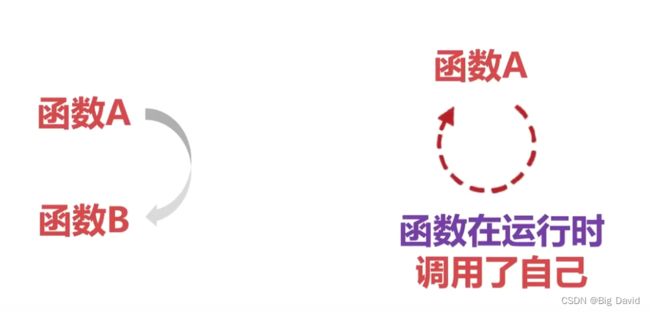
#include 12 指针
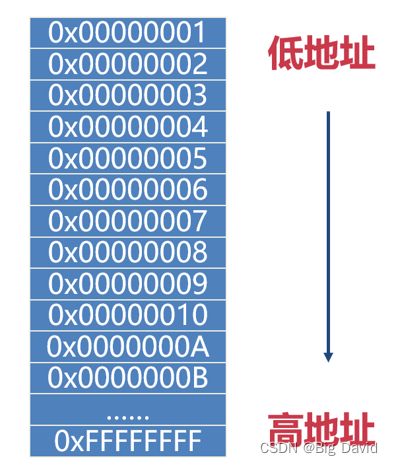
C++用运算符&获取变量在内存中的起始地址
指针变量简称指针,它是一种特殊的变量,专用于存放变量在内存中的起始地址
不管是整型、浮点型、字符型,还是其它的数据类型的变量,它的地址都是一个十六进制数。我们用整型指针存放整数型变量的地址;用字符型指针存放字符型变量的地址;用浮点型指针存放浮点型变量的地址,用自定义数据类型指针存放自定义数据类型变量的地址。
指针=&变量名
Tip:
(1) 对指针的赋值操作被称为“指向某变量”,被指向的变量数据类型称为“基类型”
(2) 指针的数据类型与基类型不符,编译会出现警告。但是,可以强制转换它们的类型
12.1 使用指针
指针用于函数的参数
值传递:函数的形参是普通变量
传地址:可以在函数中修改实参的值;减少内存拷贝,提升性能
12.2 用const修饰指针
(1)常量指针
语法:const 数据类型 *变量名
不能通过解引用的方法修改内存地址中的值(用原始的变量名是可以修改的)
1.一般用于修饰函数的形参,表示不希望在函数里修改内存地址中的值
2.如果用于形参,虽然指向的对象可以改变,但这么做没有任何意义
3.如果形参的值不需要改变,建议加上const修饰,程序可读性更好
(2)指针常量
语法:数据类型 *const 变量名
指向的变量(对象)不可改变
1.定义的同时必须初始化
2.可以通过解引用的方法修改内存地址中的值
3.C++把指针常量做了一些特别的处理,叫引用
(3)常指针常量
语法:const 数据类型 *const 变量名;
指向的变量(对象)不可改变,不能通过解引用的方法修改内存地址中的值
13 void 关键字
用途:
(1)函数返回值用void
(2)函数的参数填void,表示函数不需要参数
(3)形参用void*, 表示接受任意数据类型的指针
Tip:
1.不能用void声名变量,它不能代表一个真实的变量,但是void* 可以
2.不能对void* 指针直接解引用(需要转换成其他类型的指针)
3.把其他类型的指针赋值给void*指针不需要转换,反之要转换
#include 13 C++内存模型
内存主要分成四个区:栈、堆、数据段、代码段
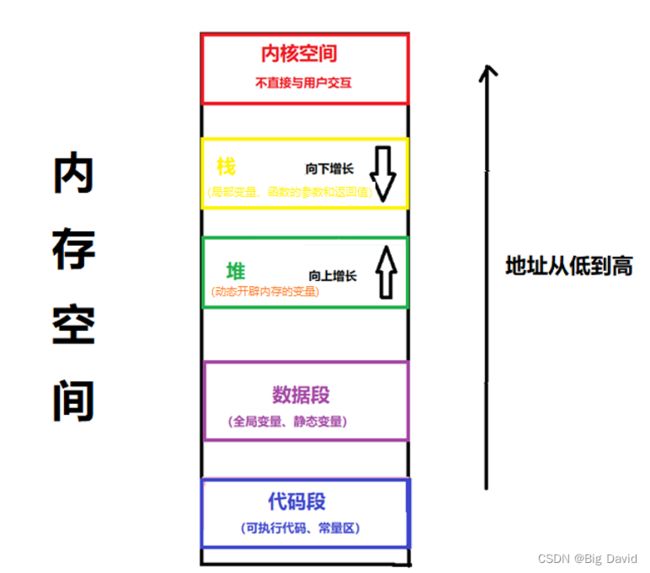
栈和堆的主要区别:
(1)管理方式不同:栈是系统自动管理的,出作用域会被自动释放;堆需要手动释放,若程序中不释放,程序结束由操作系统回收
(2)空间大小不同:堆内存大小受限于物理内存空间;而栈小的可怜,一般只有8M(可以修改系统参数)
(3)分配方式不同
(4)分配效率不同
(5)是否产生碎片
(6)增长方向不同
14 动态分配内存new和delete
栈区的效率很高,但是空间很小;如果需要处理大量的数据,就必须使用堆区的内存
#include Tip:
(1)动态分配出来的内存没有变量名,只能通过操作指针来操作内存中的数据
(2)如果动态内存分配的内存不用了,必须用delete释放它,否则有可能用尽系统的内存
(3)动态分配的内存生命周期与程序相同,程序退出时,如果没有释放,系统自动回收
(4)就算指针的作用域失效,指向的内存也不会释放
(5)用指针跟踪已分配的内存,不能跟丢
15 二级指针
指针:用于存放普通变量的地址
二级指针:存放指针变量的地址
语法:数据类型** 指针名;
1.传递地址
2.存放动态分配的内存的地址
#include 16 空指针
C/C++,用0或NULL都可以表示空指针。
声名指针后,在赋值之前,让他指向空,表示没有指向任何地址。
(1)后果:
1.对空指针解引用,程序会崩溃
2.如果对空指针使用delete运算符,系统忽略该操作,不会出现异常。所以,内存被释放后,也该把指针指向空
3.在函数中,应该判断形参是否为空指针的代码,目的是保证程序的健壮性
(2)C++11的nullptr
用0和NULL表示空指针会产生歧义,c++11建议用nullptr,(void*)0
注意:在Linux平台下,如果使用nullptr,编译需要加-std=c++11参数
#include 17 野指针
野指针:指针指向的不是一个有效合法的地址
访问野指针,可能会造成程序的崩溃
出现野指针的情况:
(1)指针未初始化
(2)指针指向了动态分配的内存,内存被释放后,指针不会置空,但是,指向的地址失效
(3)指针指向的变量已经超越变量的作用域,让指针指向了函数的局部变量,或者把函数的局部变量的地址作为返回值赋值给指针
#include 规避方法:
1.指针在定义的时候,如果没地方指,就初始化为nullptr
2.动态分配的内存被释放后,将其置为nullptr
3.函数不要返回局部变量的地址
野指针的危害比空指针大很多,访问野指针,可能会造成程序的崩溃。程序的表现是不稳定,增加了调试程序的难度
